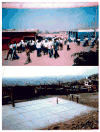Our world through our eyes: adolescents use photovoice to speak their mind on adolescent health, well-being, and sexuality in Lima, Peru
- PMID: 24737775
- PMCID: PMC4319668
- DOI: 10.1177/1524839914530400
Our world through our eyes: adolescents use photovoice to speak their mind on adolescent health, well-being, and sexuality in Lima, Peru
Abstract
Peru's approach to its 5.7 million 10- to 19-year-olds has shifted toward positive youth development. Following that trend, our objective was to facilitate Peruvian adolescents' use of photovoice to better understand the factors affecting their health, well-being, and sexuality and to work with adolescents to present policy and programmatic recommendations. Photovoice sessions were carried out with low-income 12- to 16-year-olds (n = 13) from Lima. Sessions included basic photography and ethics, photo taking, and descriptions and discussions using the SHOWeD (What do you See here? What is really Happening? How does this relate to Our lives? Why does this problem or strength exist? What can we Do about it?) method. Participants grouped their photos into a "photo story." Each section of the story consisted of a message and 4 to 10 photos. Each photo had a caption that answered the SHOWeD questions. Messages were (a) "health and well-being in danger of extinction," (b) "with some signs of hope," (c) "innocence in spite of everything," (d) "what we as adolescents have," and (e) "but we lack opportunities to live a better life and a responsible sexuality." Participants presented the photo story to program planners, policy makers, and community members. Results underscore the value of including adolescents in program and policy planning and affirm that photovoice can achieve such inclusion. Photovoice provides a concrete method for adolescents to speak their mind through image and word.
Keywords: Peru; adolescents; health; photovoice; sexuality; well-being.
© 2014 Society for Public Health Education.
Figures



Similar articles
-
Adolescents can know best: using concept mapping to identify factors and pathways driving adolescent sexuality in Lima, Peru.Soc Sci Med. 2010 Jun;70(12):2085-2095. doi: 10.1016/j.socscimed.2010.03.001. Epub 2010 Mar 16. Soc Sci Med. 2010. PMID: 20382462 Free PMC article.
-
Voices Through Cameras.Health Promot Pract. 2017 Mar;18(2):211-220. doi: 10.1177/1524839916678404. Epub 2016 Nov 21. Health Promot Pract. 2017. PMID: 27872274
-
Engaging youth through photovoice.Health Promot Pract. 2004 Jan;5(1):49-58. doi: 10.1177/1524839903258015. Health Promot Pract. 2004. PMID: 14965435
-
Outcomes and Intentionality of Action Planning in Photovoice: A Literature Review.Health Promot Pract. 2021 May;22(3):318-337. doi: 10.1177/1524839920957427. Epub 2020 Oct 9. Health Promot Pract. 2021. PMID: 33034222 Review.
-
Interviewing Adolescents About Sexual Matters.Pediatr Clin North Am. 2017 Apr;64(2):291-304. doi: 10.1016/j.pcl.2016.11.001. Pediatr Clin North Am. 2017. PMID: 28292446 Review.
Cited by
-
Adolescents' Perceptions of Sexuality: A Qualitative Study.Healthcare (Basel). 2023 Oct 18;11(20):2757. doi: 10.3390/healthcare11202757. Healthcare (Basel). 2023. PMID: 37893831 Free PMC article.
-
'All We Have to Decide Is What to Do with the Time That Is Given to Us' a Photovoice Study on Physical Activity in Nursing Homes.Int J Environ Res Public Health. 2021 May 20;18(10):5481. doi: 10.3390/ijerph18105481. Int J Environ Res Public Health. 2021. PMID: 34065443 Free PMC article.
-
What about Using Photovoice for Health and Safety?Int J Environ Res Public Health. 2021 Nov 15;18(22):11985. doi: 10.3390/ijerph182211985. Int J Environ Res Public Health. 2021. PMID: 34831740 Free PMC article.
-
'No, you should not beat our child because he will become aggressive:' Applying a multi-method approach to explore intergenerational transmission of parenting practices.PLoS One. 2021 Oct 7;16(10):e0258306. doi: 10.1371/journal.pone.0258306. eCollection 2021. PLoS One. 2021. PMID: 34618867 Free PMC article.
References
-
- Benson PL, Scales PC, Hamilton SF, Semsa A., Jr . Positive youth development: Theory, research, and applications. In: Lerner RM, editor. Handbook of Child Psychology. Theoretical models of human development. 6. Vol. 1. 2006. pp. 894–941.
- Damon W, Lerner RM, Hoboken, editors. NJ: John Wiley & Sons, Inc; Editors-in-chief.
-
- Blum RW, Mmari KN. Risk and Protective Factors Affecting Adolescent Reproductive Health in Developing Countries. Geneva, Switzerland: World Health Organization, Department of Child and Adolescent Health and Development; 2006.
-
- Brazg T, Bekemeier B, Spigner C, Huebner CE. Our community in focus: the use of photovoice for youth-driven substance abuse assessment and health promotion. Health Promotion Practice. 2011;12:502–511. - PubMed
MeSH terms
Grants and funding
LinkOut - more resources
Full Text Sources
Other Literature Sources
Medical

